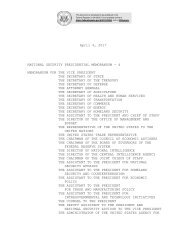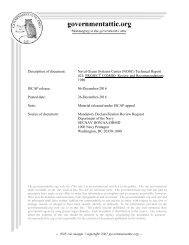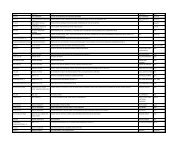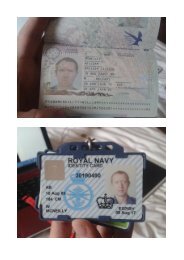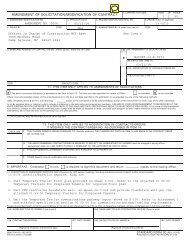government undersecretary
nsa-nazi-gold
nsa-nazi-gold
You also want an ePaper? Increase the reach of your titles
YUMPU automatically turns print PDFs into web optimized ePapers that Google loves.
DOCID: · 4232698-<br />
8EGR£l','}69MIN'h'•'*1<br />
revealed any aspect of how the intelligence w'as<br />
gathered, analyzed, and reported! 8 Often, intelligence<br />
documents were denied public release<br />
because of the singularity of their source(s). If<br />
COMINT or a particular human "asset" was the<br />
sole source of the report, and the source was still<br />
operational, then, the argument went, that source<br />
would be jeopardized by the re.Port' s release.<br />
Ideally, intelligence reports, no matter the source,<br />
were supposed to be written in such a way that<br />
the source or sources of information were transparent<br />
to the reader. However, the problem was<br />
that intelligence reports often referred openly to<br />
their sources of information. In many cases, just<br />
the way the reports were marked with classifica<br />
. tions and caveats could reveal generic sources.<br />
The agency responsible for the release of documents<br />
was considered the only judge of the<br />
"potential" for a compromise of a source that<br />
would justify not releasing a document or file. To<br />
outsiders, viewing intelligence material twentyfive<br />
years and older, this claim of compromising<br />
such old sources appeared apsurd. The process of<br />
such a determination, hidden from the public<br />
behind the walls of security clearances and<br />
beyond appeal, seemed a guarantee that useful<br />
information would not be released.<br />
~nsidering how many roadblocks<br />
there could have been to releasing the Swiss<br />
translations, the subsequent ease of their delivecy<br />
to the public came as a surprise. The documents<br />
themselves were published virtually unscathed<br />
by the classification officer's black ink. There<br />
were two reasons for this. First, precedent was in<br />
our favor. The generally error-free release of all<br />
World War II cryptologic material in 1996 (over a<br />
million pages) had mitigated much of the natural<br />
nervousness of Agency officials about the release<br />
process. Secondly, in regards to the Swiss intercept,<br />
there was no information about current<br />
"souroes and methods" to protect. In fact, what<br />
little was sanitized from the Swiss cables was a<br />
matter of protecting the privacy of individuals<br />
who were, or were thought to be, Americans.<br />
(U) Meetings and More Meetings<br />
(U) That finally brings me back to that cold<br />
and rainy March morning walking down 15th<br />
Streetto meet with the State Department historians.<br />
As it turned out, the session with them was<br />
anticlimactic. I unlocked the briefcase and handed<br />
the translations over to Dr. Slany. I told him<br />
that, in my view, there was nothing dramatic or<br />
substantively different than what he might have<br />
already seen in his research. We all relaxed after<br />
this. The latent fear amongst all historians is the<br />
appearance of some source material that radically<br />
alters the direction of any project or book.<br />
Historians prefer that "rabbit out of hat" research<br />
to occur at the beginning of a project, not near the<br />
end when all previous work can be jeopardized.<br />
I added that, except for a handful of translations<br />
of early 1945 German commercial messages from<br />
Switzerland, the set I had delivered consisted of<br />
Swiss diplomatic messages between Washington<br />
and Bern. Their substance was what would be<br />
expected during economic negotiations, full of<br />
the legal word parsing and discussions as the<br />
Swiss sought the best possible deal. They revealed<br />
some of the subtle pressures exerted on the Swiss.<br />
These included concerns about economic measures<br />
directed against . them by the allies, the<br />
"blacklists" of Swiss firms and individuals who<br />
had traded with the Axis, hold-up of import quotas<br />
on Swiss watches, and so on. The arrogance<br />
and sarcastic nature of the chief Swiss negotiator,<br />
Walter Stucki, comes through even in translation.19<br />
Dr. Slany gave me a copy of his report's<br />
chapter on intelligence to look over. A later review<br />
of it reinforced the initial impression of the<br />
impact of the Swiss translations. The NSA material<br />
added some interesting detail and perhaps<br />
allowed for an occasional "exclamation point" to<br />
the study's narrative. Dr. Slany could proceed<br />
with the drafting of his study without any worries<br />
from an NSA "surprise."<br />
(U f ~ This meeting seemed to be a reasonable<br />
finish to my efforts, and I returned to<br />
NSA satisfied, if somewhat drenched by the rain,<br />
Page 44 SEE:RHNG9MIN+J,Q(~ "



